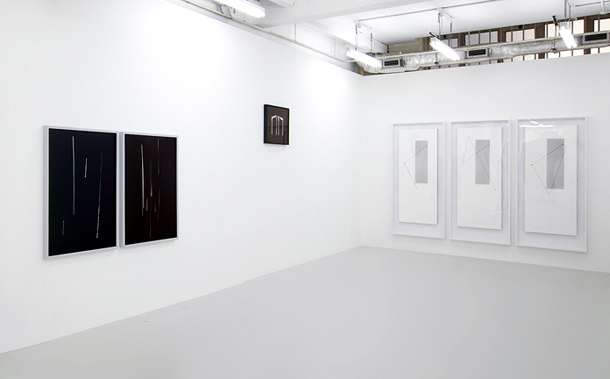
The history of photography carries with it a history of abstraction. Since its inception, artists have used the medium to transform, to lift loose the appearances of the world, and to present us with images beyond our recognition or expectation. Karl Blossfeldt’s close-up studies of plants revealed the otherworldliness of endless Fibonacci spirals, set in focus against the perfect isolation of the photographer’s white backdrop. László Moholy-Nagy’s dizzying perspectives captured a brave new technological viewpoint, whose geometric dynamism promised to propel us towards a modernist vision of utopian existence in which our capacity for movement could be infinitely extended. Fast-forward half a century, and the vast digital compositions of Andreas Gursky, in true postmodernist style, encouraged a detachment on the part of the viewer, with gridded row upon row of buildings, windows, aisles and crowds gazed upon from god-like vantage points. The dehumanising architectural reality of the past century’s modernist project was here stacked up before us, its sprawling repetitions abstracted and amplified beyond our ordinary street-level perspectives. With every detail seemingly presented with equal clarity, the resultant saturation of information overloaded our senses, stymieing our ability to discern any meaningful depth beyond the photographic surface.
More recently, Christopher Williams, with his meticulous studio photographs of high-end consumer camera equipment, sought to deconstruct our fetishisation of photographic technology itself. In the process, he created a feedback loop of sorts by simultaneously laying bare the transformative power of the photographic image, whilst utilising that very same trait to elevate his works towards a kind of (postmodernist) metaphysical pedestal (for, simply, they had become ‘art’). Both Gursky’s and Williams’s works are fabulously seductive and alienating at the same time. Their continual mediation and re-mediation insists on an endless poststructuralist deferral of meaning, prohibiting any Romantic notion of transcendent artistic creation in or of itself. We might, by now, be forgiven for feeling lost in a sea of signifiers, where the only truth is that of the medium as the message. Where, then, could photography navigate from here?
Approaching an exhibition of Stuart Bailes’s work, one could initially assume that the artist is calling for us to regress to a state of modernist idealism. Indeed, the first impression is not unlike that of entering the Prounenraum, El Lissitzky’s Suprematist masterwork of unbridled geometric potential from 1923. The angular forms of Bailes’s photographs, sitting within their voluminous box frames and crisp aluminium mounts, seem, from a distance, to slice through their own pictorial space with the assured incisiveness of a surgeon’s scalpel. It is only upon closer inspection, however, that this mark-making reveals itself to be more tentative, more fallible and human in its execution.
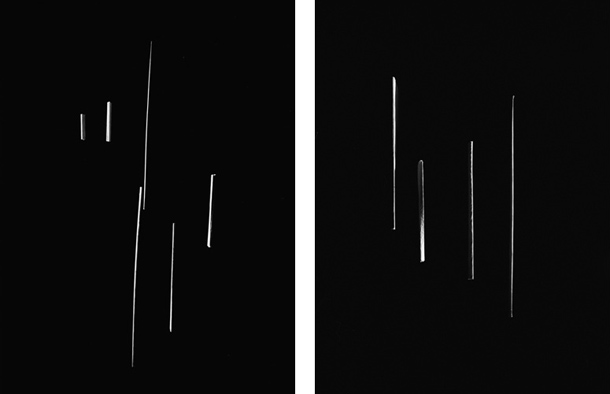
Recovery presents an array of images composed of intense black grounds, interrupted by vertical slithers of white light grouped together in various lengths and configurations. As one studies their appearance closer, the materiality of these lines hints at a low-tech cardboard and tape construction, highlighting a handcrafted aesthetic further evidenced by the jaunty parallels and bowed verticality of their arrangements. The sequence appears as if the result of some sort of quasi-scientific investigation; a homemade quantum slit experiment enacted upon the photographer’s desk. And yet, try as one might, it is impossible to fully resolve the space, to deduce its reasoning, to recover the information that preceded the birth of the image. The blackness into which the lines recede denotes depth, but also an inevitable flatness, since the lack of illumination denies the viewer enough knowledge to ascertain the precise axis of the composition’s dimensionality. The photograph masks as much as it reveals.
Our bearings are further tested with the triptych, 283 – ∆ 1658, 71 – ∆ 1853 and 2 – ∆ 816, whose ambiguous title perhaps pertains to a sequence of terrestrial coordinates. Here, each composition presents an off-kilter grey oblong block whose proportions mirror those of the large monolithic image as a whole. Across and beyond this, a taut black cord weaves its angular way through the space, layering further geometries atop the picture’s bright white surface, whilst instating a sense of temporal and topographic movement. The ends of the cord are knotted firmly in place with intricate precision, and yet the path it navigates appears far more erratic and unresolved, exploring both the pictorial space and the minimal grey monolith as if they were unknown territories. These threads, simultaneously provisional yet emphatic, incomplete yet fixed within the finality of the photographic frame, would seem to echo the artist’s voyage towards abstraction.
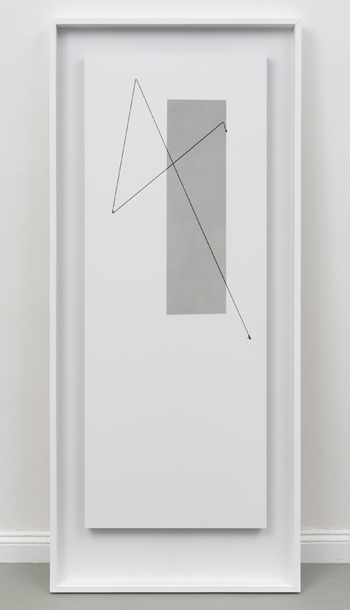
Bailes’s practice has evolved from that of a landscape photographer, in the past using elegant lighting techniques to artificially illuminate and exalt the nocturnal scenery to which he is so often drawn. His journey owes as much to Caspar David Friedrich’s Romantic quest for the sublime as it does Mondrian’s attempts to distil the world to its very essence through abstraction. Like the modernists before him, Bailes’s art seems to pursue the Absolute. His enquiries, however, demand a speculatively subjective version of the Absolute, reborn with every reading. The titles of his works (The Informants, Report, Vessel, Recovery) reflect this subjective slant, alluding to photography’s inherent tendency to conceal information by abstracting its subjects to an irreversibly two-dimensional plane, and by permitting the viewer access to only those facets deemed worthy by the photographer’s flashlight.
There is, then, an inherent contradiction at the heart of Bailes’s processes. “I don’t believe in abstraction”, he tells me, “because I think the world is already abstract.” For Bailes, the medium of photography has been thoroughly deconstructed, the rules of engagement long since agreed upon. On one level, he sees his compositions as the result of a series of binary decisions, as an empirical exploration of the world around. His aim is to show things as they are, to isolate his subjects in order to uncover a pre-existing autonomous or abstract nature. However, as he remarks of his works, “I like them for the reason that they are photographs, and they can only exist as photographs.” He revels in the transfiguration of bare materials into this kind of transcendent image-state: a process seemingly irreconcilable with the desire to show things as they truly are. Nonetheless, I would argue, Bailes is able to satisfy both these needs, to swing between positions, by knowingly adopting the role of artist as metamodern alchemist, able to reveal and transform the world in equal measure. Photography, perhaps over and above painting, is the perfect vessel for such oscillatory activity. Its creations are able to flutter with perfect ease above the threshold of ‘that which is’ (the objectively photographed scene) and ‘that which might be’ (the subjectively transcendent image).
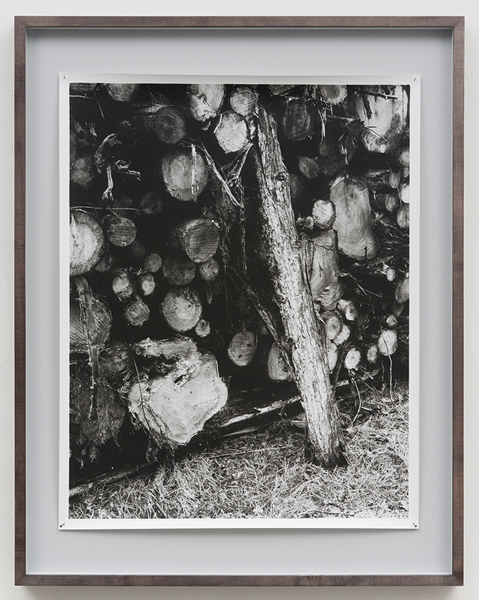
The Empiricist depicts a short piece of timber propped up against a substantial pile of logs, at once chaotic and orderly to the eye. Mounted within a pristine frame of exotic stained wood, the composition constructs and deconstructs in equal measure. Its title enforces a perverse and counterintuitive air of mysticism, leading the viewer to assemble meaning and narrative beyond the open-endedness of that which can be observed. The Informants continues along these same self-reflexive lines, presenting us with two acetate photographic gels pinned up and loosely furled against a white surface. Their colours have been rendered impotent by the monochromatic image, their forms hanging flaccid and purposeless. Scratched and thumb-marked, their appearance would seem almost to mock the modernist ideals of lightness and transparency once embodied by such materials. And yet, despite this failure, these inanimate objects invite us to negotiate their abundant shadows and reflections, compelling our eye to explore the myriad folds in the hope that we may glimpse some transcendent plane, a poetic ground that lies beyond the material realm.
As if to come full circle, Black Tabernacle, whose title invokes some sort of divine sanctuary, takes inspiration from Kazimir Malevich’s Black Square from almost a century before. Consisting of an opaque black cloth hanging from the wall, a narrow band of floor visible at the base of the image stabilises our perspective, instating a natural sense of gravitational order. Despite this, however, the rich blackness of the fabric suspended within the gelatin silver print seems to exert a pull that somehow exceeds any rational reading of the space, its darkest mysteries waiting to be uncloaked. Unlike Malevich’s work, this image does not attempt to provide an ending, an elevation of pure colour and form that would surpass all possible readings. On the contrary, as Bailes sees it, “all photographs are beginnings”. He knows full well that transcendence is impossible, providing us with enough evidence of the material world’s fixity to ground our expectations. Yet nonetheless he embarks on his creations with the full conviction of an alchemist, simultaneously leading us towards a path of poetic mysticism, along which we might also wander with blissful abandon.
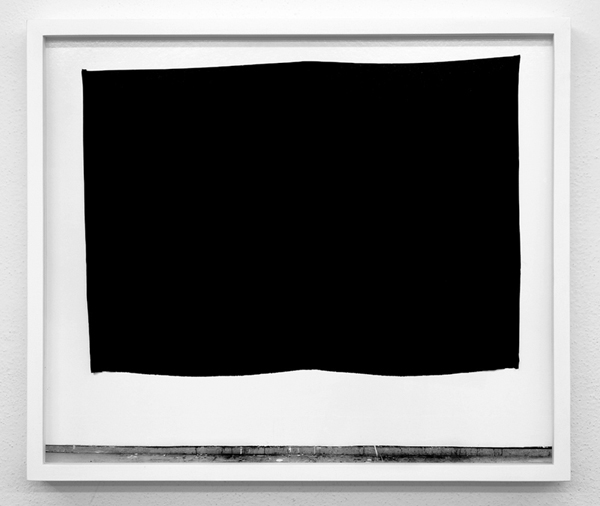
Stuart Bailes’s solo exhibition at Edel Assanti, London runs until 2nd June 2012.
